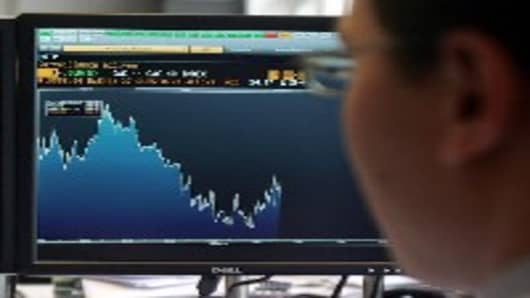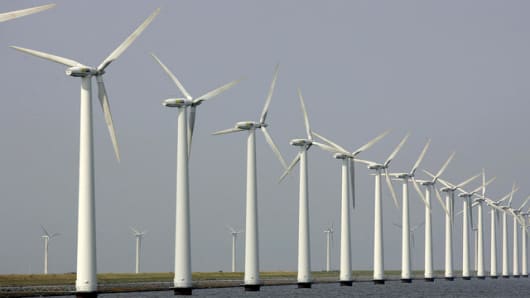Green energy stocks have slumped since their peak in November and still look overvalued, since the price of oil, although painfully high, still hasn't risen enough to justify investors' hopes that renewable energy sources will steal the limelight.
“No energy is cheaper than fossil fuels and won’t be for years to come,” says Kevin Book, analyst at FBR Capital Markets.
The Wilder-Hill New Energy Global Innovation Index, which is an average of 89 clean energy stocks worldwide, rose 58 percent in 2007, but has lost 18 percent since November, as investors retreated from riskier, less established stocks during the market jitters.
This means valuations are down to much more attractive levels, says Alice Evans, fund manager of global SRI funds at Henderson Global Investors.
And if climate-change regulations tighten further and the prices of fossil fuels continue to rise, clean energy stocks represent a fair value for investors willing to wait two to four years, Book says, adding that the true test of a new energy source is its adoption rate by private generators.
Wind and Sun
Wind energy is one of the most attractive renewable energy sources to invest in, according to Book, because the energy produced is not much more expensive than what is generated by "classical" fossil-fuels.
Another advantage of wind energy is that it creates offset credits – reductions in harmful emissions – for which no verification costs are needed.
Denmark’s Vestas Wind Systems , Spain’s Gamesa and FPL Energy in the U.S. all give investors exposure to the wind energy market and have all offered healthy gains.
Vestas shares have come through the recent market turmoil relatively unscathed and have doubled in price since the start of 2007. Gamesa’s shares have been volatile, but have gained roughly a third in the same time. FPL is up about 18 percent since the start of 2007.
The weight of investment has certainly been flowing into wind energy, as about half of investment into new clean energy projects was spent on wind farms in 2007, according to New Energy Finance.
In contrast to the soaring wind sector, solar energy faces tough challenges as it struggles to overcome a bottleneck in silicon supply - a key ingredient for solar panels - as well as increasing regulatory pressure.
The sector is also becoming more mature, says Stephan Wulf, analyst from Sal. Oppenheim, meaning investors have to carefully select where to put their money.
But for the bigger and more efficient companies, like Germany’s SolarWorldand Q-Cells, the outlook beyond 2010 is very good, Wulf says.
Shares of both SolarWorld and Q-Cells suffered a sharp correction at the start of the year, losing over a third of their value within a month. The stocks then recovered slightly, but remain well below previous highs.
Hidden Treasures and Bad Ideas
Another, less well known area of green investment is the industry focused on energy efficiency.
The retro-fitting of non-green energy producers, in other words, retro-fitting old-style power plants with new equipment to help them produce energy more efficiently and cut down on emissions, is the “greenest thing you can do,” according to Book, and represents one of the largest and most attractive areas of environmentally-friendly investment.
Two stocks operating in this area include Calgon Carbon, which specializes in air, water, and chemical processing technologies and FuelTech, which reduces air pollution from combustion units.
Shares of the Pittsburgh-based Calgon have been highly volatile over the last year, but are currently little changed from their level at the start of 2007.
Companies operating in the carbon capture sphere and the transfer and storage of carbon dioxide could also be a good bet, Book said.
The sun could be setting on the heavily-subsidized biofuels industry, as fears of deforestation and food shortages filter through to government policy makers, with many critics already labeling them a bad idea.
However, opportunities could remain with companies pushing the biofuel technologies forward, says Emma Howard Boyd, head of Jupiter Environmental Research at Jupiter Asset Management.
Companies such as Novozymes, which develop enzymes for industrial use could benefit from more stringent chemicals legislation currently being implemented in EU countries, and could provide strong returns, Boyd says.
She says the near-term outlook for clean energy stocks looks set to remain volatile, so it's important to spread out risk as green stocks are essentially a long-term investment.
To diversify, investors can also get exposure to waste management, energy efficiency, recycling, green transport and environmental consultancies such as RPS Group andRicardo, adds Boyd.




